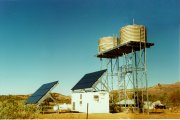 A Remote Area Power Supply (RAPS) is, as the name suggests, an electricity supply system often located in a remote area and unconnected to a major utility grid. A Remote Area Power Supply (RAPS) is, as the name suggests, an electricity supply system often located in a remote area and unconnected to a major utility grid.
These systems are also known as Stand-Alone Power Systems (SAPS).
At a minimum, a RAPS system consists of some form of electricity generation and a control system. More complex systems may use more than one electricity generation source and may also include some energy storage.
Where can they be used?
RAPS systems are
typically employed in areas where the long-term cost of connecting to a utility grid is more expensive than the life-cycle cost of a RAPS. The best type of system will depend on energy demand, location, climate, fuel cost and accessibility. As fuel prices continue to grow and exceed $1.20 in urban areas, the inclusion of renewable energy sources such as solar and wind can provide large fuel cost savings.
Why are they used?
RAPS systems are used to supply power on a small scale where grid connection is not economically viable. RAPS systems are placed close to the intended user to reduce transmission losses. This power can be used for domestic or commercial purposes.
 There are many types of generation schemes used, from conventional diesel to solar, wind and hydro, and many energy storage technologies available, each providing their own specific advantages and disadvantages. Lucrative government incentives, providing rebates of up to 50% (70% in special cases) of the capital cost, are also available when considering a RAPS system that includes significant amounts of renewable energy generation (displacing diesel fuel use). Further information on Australian Government rebates can be found at the Australian Greenhouse Office web site. There are many types of generation schemes used, from conventional diesel to solar, wind and hydro, and many energy storage technologies available, each providing their own specific advantages and disadvantages. Lucrative government incentives, providing rebates of up to 50% (70% in special cases) of the capital cost, are also available when considering a RAPS system that includes significant amounts of renewable energy generation (displacing diesel fuel use). Further information on Australian Government rebates can be found at the Australian Greenhouse Office web site.
Typically, the cost of a RAPS for a single house ranges between $15,000-$50,000, depending on the number of appliances, their power ratings and the amount of time they are in use. The life-cycle cost over some 20 years is often cheaper than cost of connecting to the grid and the associated energy costs.
There are many operational RAPS in Australia that have been designed for purposes including:
- Powering single homes
- Pumping water on cattle stations
- Powering aboriginal outstations or even communities
- Powering remote farm houses
- Telecommunications infrastructure
- Powering tourist ventures
- Powering scientific research communities (Australian Antarctic Division)
- Running lighthouses, buoy’s, channel markers etc.
- Powering sailing boats, campervans etc.
A large number of aboriginal outstations have been consulted under the ‘Bushlight’ program providing hybrid RAPS for basic living in these areas.
Further information about remote area power systems can be found through the Research Institute for Sustainable Energy web site and the Australian Greenhouse Office web site.
|
|

